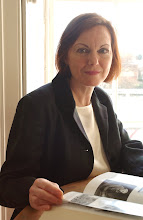
Nick Harmer’s great grandfather, George Frederick Harmer (1841-1911), came from a large family of ornamental plasterers who worked on many of the eminent houses in Bloomsbury. Indeed, George’s father, James (b. 1800), had an exhibit of ornmental plaster work in the Great Exhibition in Hyde Park, London (1851).
George Harmer was married in the Church of Christ the King, in 1872, where he was an organist. A photograph of the church, on Gordon Square, is featured on the blog entry for 2 July 2009 (see "Photos of your Bloomsbury ancestors’ homes and workplaces"). It was built between 1850-54 for the Catholic Apostolic movement, which began and ended in Bloomsbury, and which is associated with a Scottish minister, Edward Irving (1792-1834). Irving arrived in London in 1822 and for a time won followers with his eloquence and commanding presence. When he became increasingly drawn into a belief in the apostolic gifts of prophecy and healing, he was excommunicated by the presbytery of London (1830) and from the ministry of the Church of Scotland (1833). The Catholic Apostolic movement claimed to be restoring the Apostolate so that Christianity would be ready for the Second Coming of Christ. Membership gradually declined after 1900 although the movement had spread to about 1000 congregations in some 20 countries.
George Harmer played the organ at the Church of Christ the King but was an elder at the movement’s church in Mare Street, Hackney, established in 1874 (photo above by Fin Fahey, Flickr). Nick says that there is a plaque commemorating George in one of these churches. Our roving researcher, Dr Deborah Colville, has been unable to find it in the Bloomsbury church so it may be in Christ Apostolic Church, Hackney. This is a Grade II listed building and much of interior has survived intact. If anyone has information about this plaque, we would very much like to hear from you.
George Harmer was married in the Church of Christ the King, in 1872, where he was an organist. A photograph of the church, on Gordon Square, is featured on the blog entry for 2 July 2009 (see "Photos of your Bloomsbury ancestors’ homes and workplaces"). It was built between 1850-54 for the Catholic Apostolic movement, which began and ended in Bloomsbury, and which is associated with a Scottish minister, Edward Irving (1792-1834). Irving arrived in London in 1822 and for a time won followers with his eloquence and commanding presence. When he became increasingly drawn into a belief in the apostolic gifts of prophecy and healing, he was excommunicated by the presbytery of London (1830) and from the ministry of the Church of Scotland (1833). The Catholic Apostolic movement claimed to be restoring the Apostolate so that Christianity would be ready for the Second Coming of Christ. Membership gradually declined after 1900 although the movement had spread to about 1000 congregations in some 20 countries.
George Harmer played the organ at the Church of Christ the King but was an elder at the movement’s church in Mare Street, Hackney, established in 1874 (photo above by Fin Fahey, Flickr). Nick says that there is a plaque commemorating George in one of these churches. Our roving researcher, Dr Deborah Colville, has been unable to find it in the Bloomsbury church so it may be in Christ Apostolic Church, Hackney. This is a Grade II listed building and much of interior has survived intact. If anyone has information about this plaque, we would very much like to hear from you.
